Jelenia Góra- Lower Silesian 作者: 来源: 发布时间:2021-07-14
Ⅰ. Population and Area
Population (2018)
• Total 79,480 Decrease (45th)
• Density 730/km2 (1,900/sq mi)
Area
• Total 109.2 km2 (42.2 sq mi)
Website http://www.jeleniagora.pl/
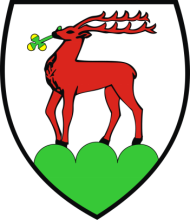
Ⅱ.Natural Geography (environment and resources)
-City is located in the northern part of the Jelenia Góra Valley. From the west, the city is surrounded by mountains and foothills of Izera Mountains, north Kaczawskie Mountains, east Rudawy Janowickie Mountains and in the south Karkonosze Mountains. The center is located about 1 km (0.6 mi) east from place where two rivers Bóbr (Beaver River) and Kamienna (Stone River) connect.
-Home to nearly 100,000 inhabitants, Jelenia Gora is the largest city of the western Sudety Mountains. It is situated in the Lower Silesian voivodship, approximately 110 km southwest of Wroclaw, 60 km from the border with Germany and only 25 km from the border with the Czech Republic.
-Jelenia Gora lies some 350 meters above sea level, in the valleys of the rivers Bobr and Kamienna. As it is ringed on all sides by mountain ranges, the city has a climate typical of mountainous regions, with temperatures higher in spring than in autumn and relatively warm winters.
-Natural values
-The natural values of the main ranges of the Western Sudetes have a great influence on the attractiveness of the region and the city. These ranges are arranged almost perpendicular to each other, separating the vast Jelenia Góra Basin, about 200 km². It is the geographical environment of the region in which Jelenia Góra is located that makes it a beautiful, picturesque, surprising and eagerly visited place.
-Karkonosze is the highest granite massif of the Sudetes (Śnieżka 1603m above sea level). It has generally gentle shapes and a smooth ridge surface above which granite rocks with fanciful shapes rise. The massif is cut in several places by deep glacial cauldrons - Wielki and Mały Staw, Śnieżne Kotły, Kocioł Łomniczki and Czarny Kocioł Jagniątkowski . Another variety are the streams flowing from the mountains, creating beautiful waterfalls: Kamieńczyk 27m (the largest in the Sudetes), Szklarki and Podgórna. Almost all plant zones typical of high mountains can be found in the Karkonosze Mountains. In the forest you can meet wild boar, deer, roe deer and mouflons imported from Corsica.
-The Kaczawskie Mountains, covered with deciduous and spruce forests, hide many mysterious caves and excavations left by prospectors of gold, silver and precious stones. They belong to the most extensive mountain ranges in the Sudetes. In the part of the Eastern Ridge, there is the largest concentration of karst formations. From the Widok Pass you can see the most beautiful panorama of the Jelenia Góra Valley and the Karkonosze Mountains. For magnificent views, it is also worth going to the glider mountain.
-The Kamienna River, flowing through a deep valley, forms a natural border between the Karkonosze and the Izerskie Mountains, which are formed by four parallel ridges. It is the westernmost range of the Sudetes. Its natural peculiarity is its extensive peat bogs (the Izerskie-Jakuszyce Peatland Reserve was established), occurring on flat ridges and numerous rock groups protruding above the ridge level.
-The two twin cones visible from the whole of the Valley are Krzyżna Góra and Sokolik - a double rocky crag with a viewing platform. They belong to the Sokole Mountains, which are part of the Rudawy Janowickie. The unique abundance of rock forms and several dozen meters long naked crags, where the greatest Polish climbers, headed by Jerzy Kukuczka and Wanda Rutkiewicz, trained, are a recognized rock climbing site. This area is under protection by creating the Rudawski Landscape Park .
-The Karkonosze National Park , one of the largest in Poland, lies partly within the borders of Jelenia Góra. Its management is located in Sobieszów at the foot of Mount Chojnik, which is also an enclave of KPN. It is covered with a mixed forest. Another attractive landscape park is the Bóbr Valley Landscape Park with one of the most beautiful gorges in the area - Borowy Jar. There are also many natural monuments in the city itself, mainly old trees. These are: English oaks, small-leaved lindens and white willows. Moreover, monumental trees grow on the Krzywousty Hill, in Cieplice and in Sobieszów. There are forest parks in the city - large and small, as well as squares and lawns.
-Transport
-Major airports near Jelenia Gora, Poland:
-The nearest major airport is Copernicus Airport Wrocław (WRO / EPWR). This airport has international and domestic flights from Wroclaw, Poland and is 111 km from the center of Jelenia Gora, Poland.
-Another major airport is Pardubice Airport (PED / LKPD), which has international flights from Pardubice, Czech Republic and is 134 km from Jelenia Gora, Poland.
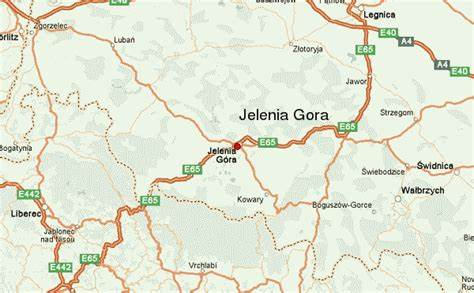
Ⅲ.Economy
-Jelenia Góra is a town directly bordering the Czech Republic and located close to Germany. Improving communication (the planned construction of the S3 section, modernization of the railway line, modern Pendolino running on the Warsaw-Jelenia Góra route) is conducive to business development and the emergence of new investments.
-Jelenia Góra is also an important educational center educating at a high level, among others economists and engineers. Annually, about 1000 students leave the walls of Jelenia Góra universities, with qualifications in accounting and financial consulting, managerial economics, quality management, industrial information technology, telecommunications, journalism and social communication, English and German philology, hotel and gastronomy, etc. Young, well-educated people with enthusiasm for work can certainly be a strong pillar in the development of emerging companies.
-The unique location creates unique opportunities. In order to make the best use of the existing potential, the city's local authorities conduct large-scale investments that improve the quality of infrastructure and living conditions of the inhabitants. Investments, the value of which is already in the hundreds of millions of zlotys, concern both the technical infrastructure: water and sewage network, sanitation, roads, as well as making the tourist, cultural and spa offer more attractive. The scale of local government investments has boosted the city's development and increased its attractiveness, which has already attracted many investors. There is an Industrial Zone in the city, which covers approx. 80 hectares of land intended for investment, attractively located by the main communication route towards the Czech Republic and Germany. These areas also contain land belonging to the Kamienna Góra Special Economic Zone for Small Business. In addition to the areas intended for industrial investments, the city also offers attractive undeveloped and developed properties located in tourist and spa areas, including with boreholes in geothermal waters.
-We have streamlined the investment process in the city to create a chance for development for all those who invest here. The city provides each investor with professional service throughout the investment process, support through acceleration of administrative procedures necessary to start the investment and a real estate tax exemption program as part of de minimis aid for entrepreneurs creating new jobs.
-Jelenia Góra creates conditions for living and working in harmony. It is a city friendly to residents, open to tourists, creating optimal conditions for the functioning and development of entrepreneurs and investors. This place can also become your chance for success.
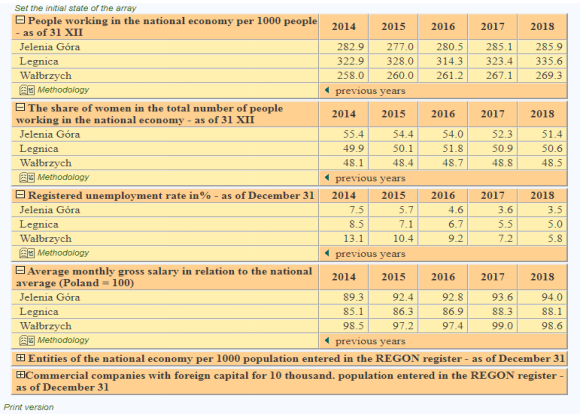
Ⅳ.Industrial Characteristics
-Jelenia Góra is a prosperous city. This is mainly due to an economy based on a modern and dynamic enterprise. In the joint venture, there are nearly 13000 traders and 1400 traders: 350 foreign traders and about 8000 natural persons with economic capacity. The mining sector dominates the structure of the economic sector: trade, real estate, hotels and restaurants. The city has also developed electrical engineering, plastic processing, and automobile and furniture industries.
-Jelenia Góra is a city with a rich, 900-year-long tradition related to trade, medicine and science, famous for its enterprising and inventive inhabitants, it is finally a dynamic, modern center of tourist and economic development. The unique attractiveness and dynamics of development, fascinating history and wonderful monuments, picturesque location, hot thermal springs, as well as a rich cultural, sports and educational offer have made Jelenia Góra the Pearl of the Karkonosze Mountains. This is where tourists from Szklarska Poreba, Karpacz or Świeradów Zdrój "come" to take advantage of the city's rich offer.
-Key projects
1. Polish - Czech promotion of the Towns of Jelenia Góra and Jablonec nad Nisou - Stage II
-The main goal of the project is to develop and strengthen the competitiveness of the Polish-Czech border area, to maximize the opportunities resulting from the favorable geographical location of Jelenia Góra and Jablonec nad Nisou.
-Kroniki Projektów 2014-2024 | Miasto Jelenia Góra https://miasto.jeleniagora.pl/content/kroniki-projekt%C3%B3w-2014-2024
-2. The Education Key to Career project - a comprehensive development program for students from three school complexes in the City of Jelenia Góra
-The project "Education is the key to career - a comprehensive program for the development of students of three school complexes in the city of Jelenia Góra" is a project implemented by Syntea SA in partnership with the city of Jelenia Góra.
-Kroniki Projektów 2014-2024 | Miasto Jelenia Góra https://miasto.jeleniagora.pl/content/kroniki-projekt%C3%B3w-2014-2024
Ⅴ.Attrations and Cityscape
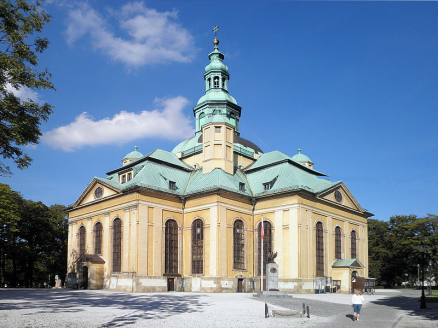
Holy Cross Church, 18th-century
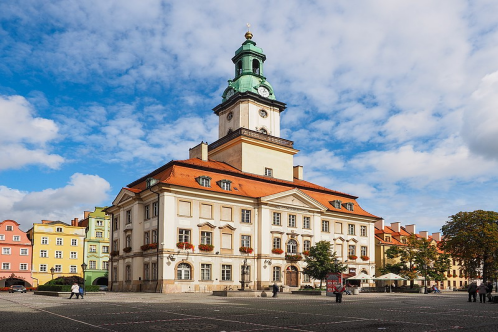
Town Hall, built between 1744 and 1749, is located on the main square
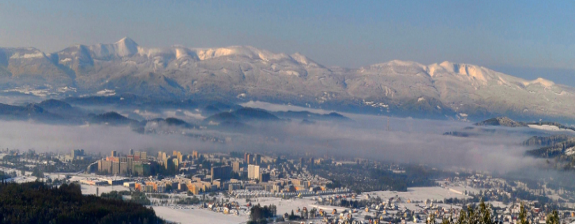
Jelenia Gora Panorama, view from Mount Szybowcowa (Schieferberg)
-The focal point of Jelenia Gora is its market place encircled by Baroque houses, giving this place a certain aura. In the very centre stands the 17th century Town Hall, erected in the aftermath of the great fire that destroyed much of Jelenia Gora at that time. Also dating from the 17th century and located in front of the Town Hall is a stone fountain with a figure of Neptune. Near the market place you will find a true gem, the St. Erasmus and Pankracy church, built in the 15th century. Altered in subsequent centuries, today the church combines Gothic, Renaissance and Baroque architectural elements.
-A sight not to be missed is the Baroque St. Cross’ Church, erected in the 17th century by a Swedish architect who designed it to be a precise copy of St. Catherine’s Church in Stockholm.
-Last but not least, Jelenia Gora has a local museum situated just outside the Old Town. Besides the permanent collection consisting mostly of glass and old photographs, the museum holds cyclical exhibitions that are worth attending.
-The Wojanowska gate and tower were part of the medieval defence complex that protected the road to Wojanów. Dungeons served as a prison. In 1480, the tower due to strong wind collapsed burying five people. Quickly it was rebuilt by adding the clock and the dome with a lantern, and this state has survived to this day. Coats of arms have been placed on the pillars: Prussian, Silesia, urban and inscription. In 1869, the gate was dismantled and moved to the barracks at Obrońców Pokoju Street. After the renovation in 1998, returned to its former place. Located inside the medieval bastion was the St. Anne Chapel of the Wojanowska gate. In the portal above the entrance to the chapel there is an inscription: " „HonorI Magnae ChrIstI aVlae DIVae Annae ereCta”"(built for the glory of the great grandmother of Christ, St. Anna) with a hidden date of 1715.
-The Basilica of St. Erasmus and St. Pancras built in the 14th century features the chapel dedicated to the Patrons of Jelenia Gora; however, it got its present form in the next century. The church was built of stone in the form of a three-nave basilica topped with a tower. Even today, you can admire numerous Gothic stone details best preserved in portals and window frames. The southern portal is exceptionally rich and interesting. Two sepulchral chapels (from the 17th and 18th century) were built into the church's walls; over 20 epitaphs and tombstones from the 16th and 18th century was placed on the two chapels. The main entrance to the chapel is located on the west, on the ground floor. The interior is also Gothic, but the fittings come from Renaissance and Baroque. The incredibly rich and monumental altar from the 18th century dominates the interior. The temple also houses priceless organs from the same period made in the workshop of an Italian organ builder – Adam Casparini. The 16th-century pulpit and the intarsiated (made of different wood types) choir stalls are a little older. There are also two 18th century figures on the church grounds – the Marian column is near the main entrance, and on the northern side, there is a sculpture of St. John of Nepomuk. It used to be located on one bridge over the Młynowka River; however, after it was damaged and then reconstructed in the 19th century, it was moved to its present place.
-Feast of the Holy Cross Church
-The Feast of the Holy Cross Church was erected as a proof of the grace of the Catholic Emperor of Austria for the Silesian evangelicals. Under the arrangement concluded in Altranstadt after a religious war they were granted the right to build six churches in Silesia which at that time was under Austrian rule. The design of the temple was prepared by the architect, Martin Frantz of Tallinn. The construction works lasted nine years (1709–1718) and the newly built church was deceptively similar to its prototype – St. Catherine's Church in Stockholm (the work of the same designer). The structure was erected on the plan of a cross and topped with a dome. The interior was equipped with a three-storey matronea which can accommodate more than two thousand members of the congregation. The railings were adorned with citations and paintings displaying scenes from the Old and New Testament. The altar together with the organ front placed over it makes up an extended, beautifully adorned architectural form.
-The town hall is the central point of the market square. The building was erected between 1744 and 1749. The entire square is surrounded by Baroque tenement houses with arcades, which originally used to serve the merchants to sell their goods. At the beginning of the 20th century, the tenement houses near the City Hall were bought and adjoined to the town hall (the so-called "Seven-Houses"). Right next to the town hall there is a fountain with a sculpture of Neptune – god of the seas. The sculpture is to commemorate old trade relations with overseas lands.
-Schaffgotsch Palace – Cieplice
-The Schaffgotsch family ruling vast lands around Karkonosze settled in Cieplice in 1675. Their previous seat was Chojnik Castle, burned down due to lightning strike. Their Schaffgotsch Palace's greatest ornaments are the two semi-circular finished porticos with richly ornamented cartouches carrying the family crest of the owners. The interiors boast early classicistic fittings. The palace currently houses a branch of the Wrocław University of Technology.
-a trams – Tram communication operated in Jelenia Góra in the years 1897–1969. Today there isn't much left of it – fragments of the tram line and a plaque can be found near town hall. One of the old tram carriages can be found by the north entrance to the town hall and serves as a souvenir kiosk (the other two trams are placed in front of the tram depot, in Wolności Street and at the bus terminal in Podgórzyn).
Ⅵ.History and Culture
-Established in 1108 as a durable stronghold by the Polish King Boleslaw III Krzywousty (Boleslaus the Wrymouth), Jelenia Gora was granted town privileges prior to 1288, which greatly enhanced its economic development. The town rapidly grew to be an important centre for manufacturing glass, steel and high quality textiles. It was its industry that saved Jelenia Gora from extinction up to the 18th century and therefore it is not at all surprising to learn that once it fell in the hands of Prussia, Jelenia Gora became a fundamental location for the German industrial revolution.
-With the coming of the 19th century, the city went through a new economic boom. The railway connections with Zgorzelec (1866) and Wroclaw (1867) as well as a nascent tourist industry stimulated the growth of the city. Left practically undamaged by World War II, Jelenia Gora came under the Polish administration and kept its status as a thriving tourist destination.
-The nucleus of the almost 90 thousand of the town's inhabitants there was a Slavic stronghold, situated on today's Krzywoustego Hill, at the confluence of the Bóbr and Kamienna rivers.
-Established at the turn of the 11th and 12th centuries (according to the tradition of 1108-11), it is associated with the person of Prince Bolesław the Wrymouth. The craft and market settlement, established at the foot of the stronghold, received Magdeburg municipal rights before 1288, and its convenient location at the crossroads of important trade routes to Bohemia and Germany enabled its dynamic development. The young town received numerous privileges from the Silesian rulers and in the following centuries it became famous for the production and export of linen, it was also a mining and metallurgical center based on raw materials supplied from nearby Kowary.
-In 1392, Jelenia Góra came under Czech rule, and in 1527, after the death of King Ludwik, the last of the Jagiellonians on the Czech throne, the city fell within the boundaries of the Habsburg monarchy. Another turning point in history was the outbreak of the bloody Thirty Years' War (1618-1648), after which the city recovered from its destruction thanks to the production of linen. The rapid development of tourism in the 18th century and the interest in the mountains surrounding the Jelenia Góra Valley helped the inhabitants to overcome another crisis, this time caused by the Silesian wars. Their political consequence was the affiliation of Jelenia Góra to Prussia, and then to Germany. This situation lasted until the end of World War II. In 1947, not affected by the effects of the war, the town became a separate town. The post-war urbanization and industrial development made that after the administrative reform in 1975, Jelenia Góra became the capital of the voivodeship. Today it is a city with the rights of a town poviat.
-Positive changes in recent years, which we can observe while walking through the city center, and thus numerous renovation works of monuments and tenement houses, and the establishment of new green areas, contribute to the creation of a new character of Jelenia Góra, rightly called the "Pearl of the Karkonosze ". Currently, the city also includes the following districts: Maciejowa, Czarne, Goduszyn, Cieplice, Sobieszów and Jagniątków.
Ⅶ.Other Information
Jelenia Góra; German: Hirschberg im Riesengebirge; Exonym: Deer Mountain; Silesian: Jelyńo Gůra) is a historic city in southwestern Poland, within the historical region of Lower Silesia. Jelenia Góra is situated in the Lower Silesian Voivodeship, close to the Krkonoše mountain range running along the Polish-Czech border – ski resorts such as Karpacz and Szklarska Poręba are situated 10 to 15 kilometres (6 to 9 miles) from the city. Jelenia Góra constitutes a separate urban gmina as well as being the seat of surrounding Jelenia Góra County. In 2018 the population of Jelenia Góra was 79,480. The area, including the oldest spa district of Cieplice Śląskie-Zdrój, is one of the most valued recreational and leisure spots in Poland.
Ⅷ.Contact Information
Mayor Jerzy Łużniak
Pl. Ratuszowy 58 Sudecka 2958-500 Jelenia Góra
Phone: +48 75 754 61 01
+48 75 754 62 10
Fax +48 75 754 61 59
E-mail: ratusz@jeleniagora.pl
